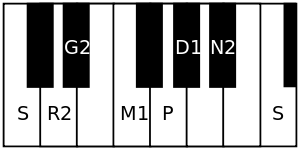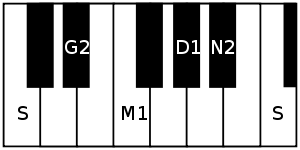Saramati
| Arohanam | S R₂ G₂ M₁ P D₁ N₂ Ṡ |
|---|---|
| Avarohanam | Ṡ N₂ D₁ M₁ G₂ S |
| Carnatic music |
|---|
Tanjavur-style Tambura |
| Concepts |
| Compositions |
| Instruments |
|
Saramati is a rāgam in Carnatic music (musical scale of South Indian classical music). It is a janya rāgam (derived scale) from the 20th melakarta scale Natabhairavi.[1] It is a janya scale, as it does not have all the seven swaras (musical notes) in the descending scale.
Structure and Lakshana


Saramati is an asymmetric rāgam that does not contain panchamam or rishabham in the descending scale. It is a combination of the sampurna raga scale Natabhairavi and pentatonic scale Hindolam. It is an sampurna-audava rāgam (or owdava rāgam, meaning pentatonic descending scale).[1][2] Its ārohaṇa-avarohaṇa structure (ascending and descending scale) is as follows:
- ārohaṇa : S R₂ G₂ M₁ P D₁ N₂ Ṡ[lower-alpha 1]
- avarohaṇa : Ṡ N₂ D₁ M₁ G₂ S[lower-alpha 2]
The notes used in this scale are shadjam, chathusruthi rishabham, sadharana gandharam, panchamam, shuddha dhaivatham and kaisiki nishadham in ascending scale, with panchamam and rishabham dropped in descending scale. For the details of the notations and terms, see swaras in Carnatic music.
Popular compositions
A few compositions have been set to Saramati rāgam. "Bharata Bhooshira mandira sundari " from the movie upasane is based on this raga composed by vijaya bhaskar. A popular kriti composed in it is Mokshamugalada by Tyagaraja. Another one is Manasaramati-saramati- Tanjavur Shankara Iyer and Sarasadala nayane Saramathi Ragam Muthaiah Bhagavathar.
Music composer Ilaiyaraaja has set the Tyagaraja krithi "Mari Mari Ninne" to this Raga, even though the actual krithi is in the raga Kambhoji.
- Shârade Namaste and Sâramati Saraswati by Kalyani Varadarajan
Related rāgams
This section covers the theoretical and scientific aspect of this rāgam.
Scale similarities
- Hindolam has a symmetric pentatonic scale, with the notes same as the descending scale of Saramati. Its ārohaṇa-avarohaṇa structure is S G2 M1 D1 N2 S : S N2 D1 M1 G2 S